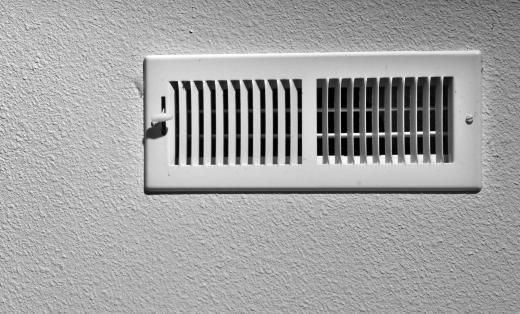An air conditioning vent is the opening through which air escapes from an air conditioning unit. Depending on the type of air conditioning unit, the vent may expel either exhaust or cool air. Exhaust vents are most often seen in portable air conditioning units, usually as a hose that extends out a door or window to expel the exhaust outside. Wall air conditioning units have a built-in vent located on the back, outside portion of the unit that expels the exhaust air to the outside. On central air conditioning units, the openings in the wall or floor of the building through which cool air is distributed are called the air conditioning vents.
Designed to allow air conditioning in rooms or buildings with no permanent air conditioning unit, a portable air conditioning unit is a self-contained air conditioning machine that can be moved from room to room. This type of unit has a flexible exhaust pipe acting as an air conditioning vent that removes hot air from the cooled room. Proper installation of a vent is vital to the function of a portable air conditioning unit. The more efficiently the exhaust air escapes, the better the unit is able to perform. Long exhaust hoses can sometimes transfer heat back into the room by warming the hose, so some vent hoses are insulated to prevent the heat transfer.

Some units require that the user installs a ventilation kit, which is a specially shaped housing for the end of the hose that creates a tight seal around the air conditioning vent location. These kits are similar to the units used by installation technicians to seamlessly install a new car stereo. Improper installation of the ventilation hose on a portable air conditioning unit can cause hot air from the unit to expel back into the cooled room. Poorly installed or badly sealed vent openings in windows and doors can leak hot air from the outside back into the cooled building.

In a central air conditioning unit, air conditioning vents are most likely seen high up on the wall or on the periphery of a room near the floorboards. The holes are made more attractive by using an air grille or decorative air conditioning vent cover, which can also serve to keep debris from the vent shaft from flying into the room. Some central air conditioning unit fans depend upon the sealed nature of the unit to work correctly. Installing an additional vent in a central air conditioning unit can cause the unit's fan to malfunction, so new vents on a central air conditioning system must be installed by a professional heating, ventilation and air conditioning (HVAC) contractor.
